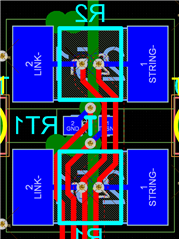Hello - I am trying to figure out what the maximum theoretical accuracy of the BQ76952 current measurement is without calibration.
My design is using a 1mOhm current sense resistor (1%, 75ppm temperature coefficient). I am testing using a current limited power supply set to 50A output.
When I calculate the maximum theoretical accuracy at 50A, given the parameters in the datasheet, I find the maximum error @ 25C should be between -1.55A and 1.17A. But when actually running 50A through the board, the AFE is reporting 54.77A.
My error calculations:
- Rsns_max = 1mOhm + 1% = 1.01mOhm
- VREF2_max @ 25C = 1.25V
- LSB_max = VREF2_min / (5*2^15) = 7.63uV
- Gain_max = 132,335 * LSB / 1V = 1.00964
- VCC_offset_max = 1 * LSB = 7.63uV
- VCC_offset_drift_max = 0V @ 25C
- INL_max = 22.3 * LSB = 170uV
- DNL_max = 0.1 * LSB = 0.763uV
Vmeasured_max = Current * Rsns_max * Gain_max + VCC_offset_max + INL_max + DNL_max
= 50A * 1.01mOhm * 1.00964 + 7.63uV + 170uV + 0.763uV = 51.17mV
Icalculated = 51.17mV / 1mOhm = 51.17A --> 1.17A maximum error
Following the same process for negative error, I find -1.55A is the maximum negative error I should see when applying 50A. But as noted above, I am seeing 4.7A measurement error.
Am I missing something in my calculations?
Thank you for your help,
Jessica


